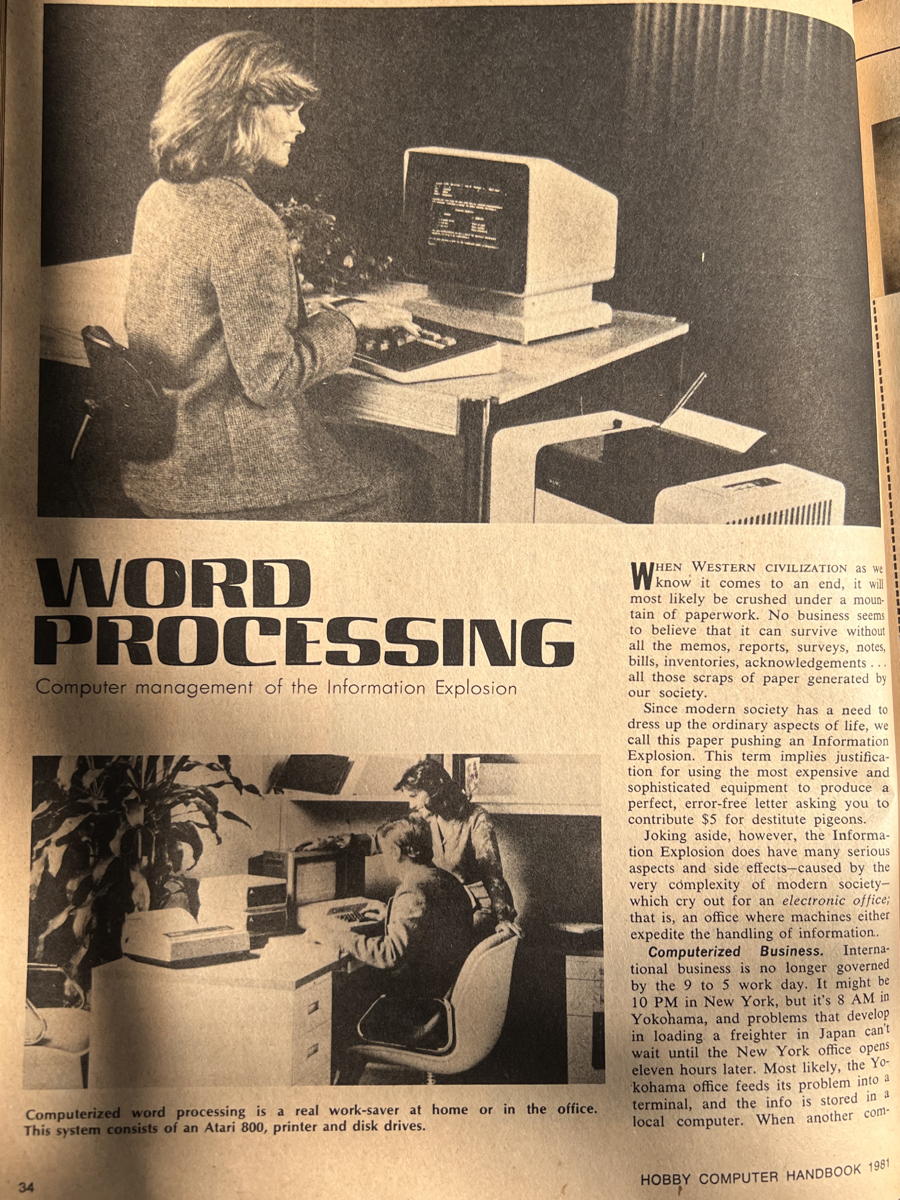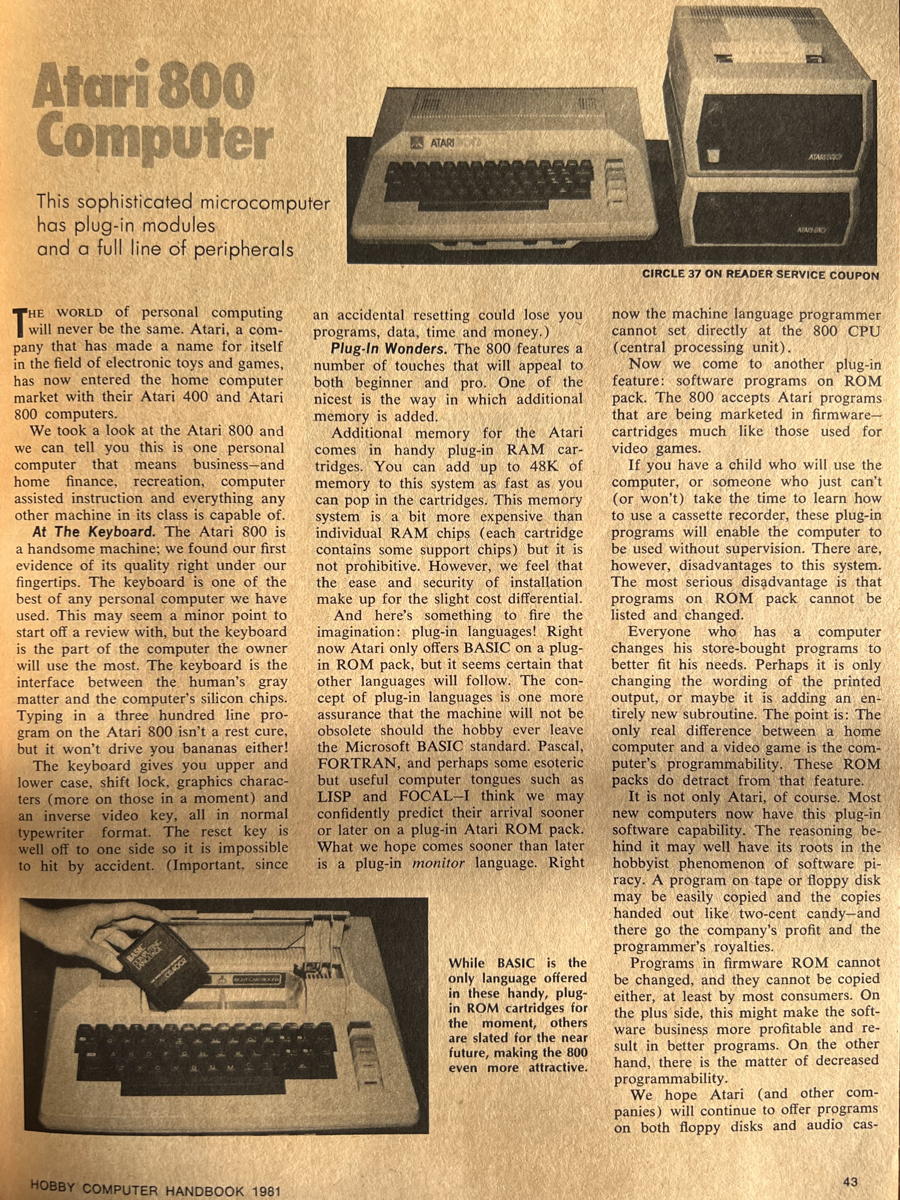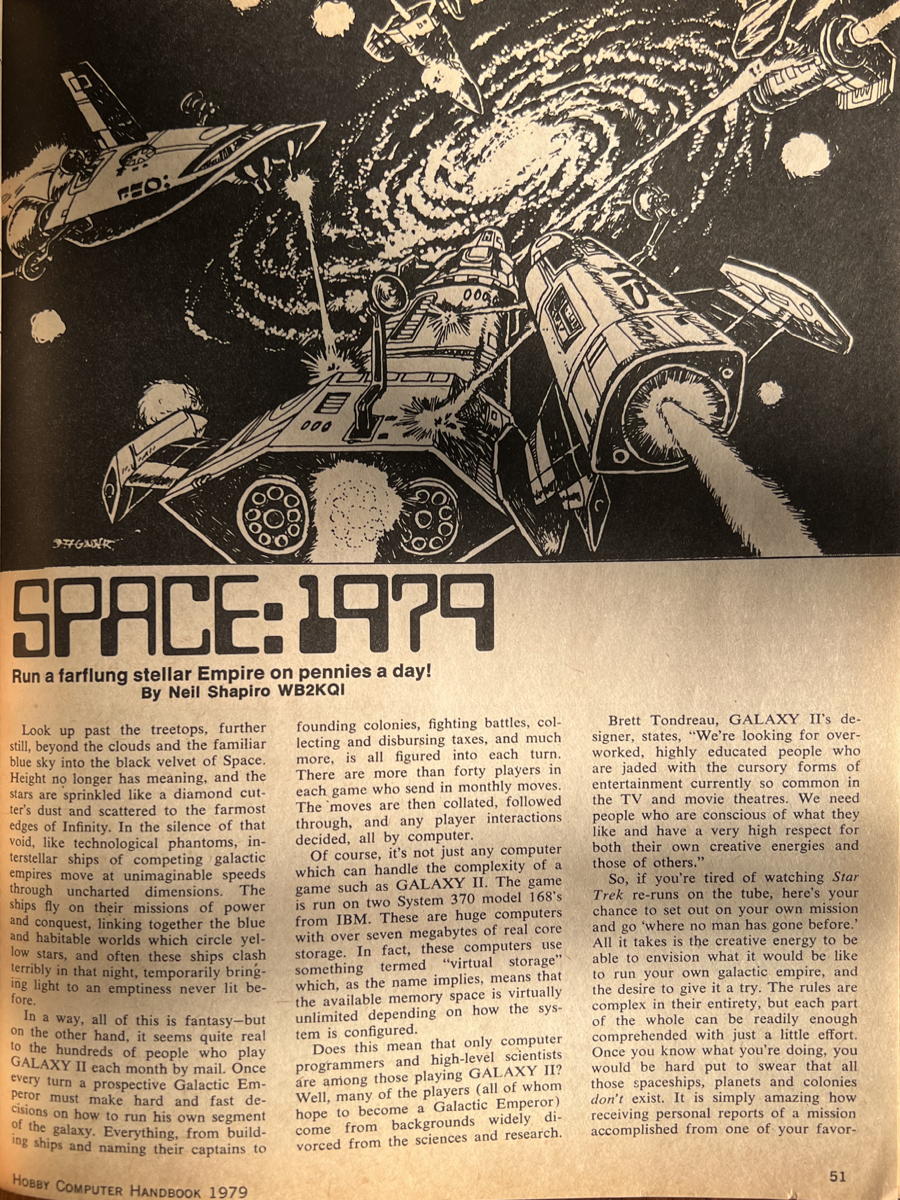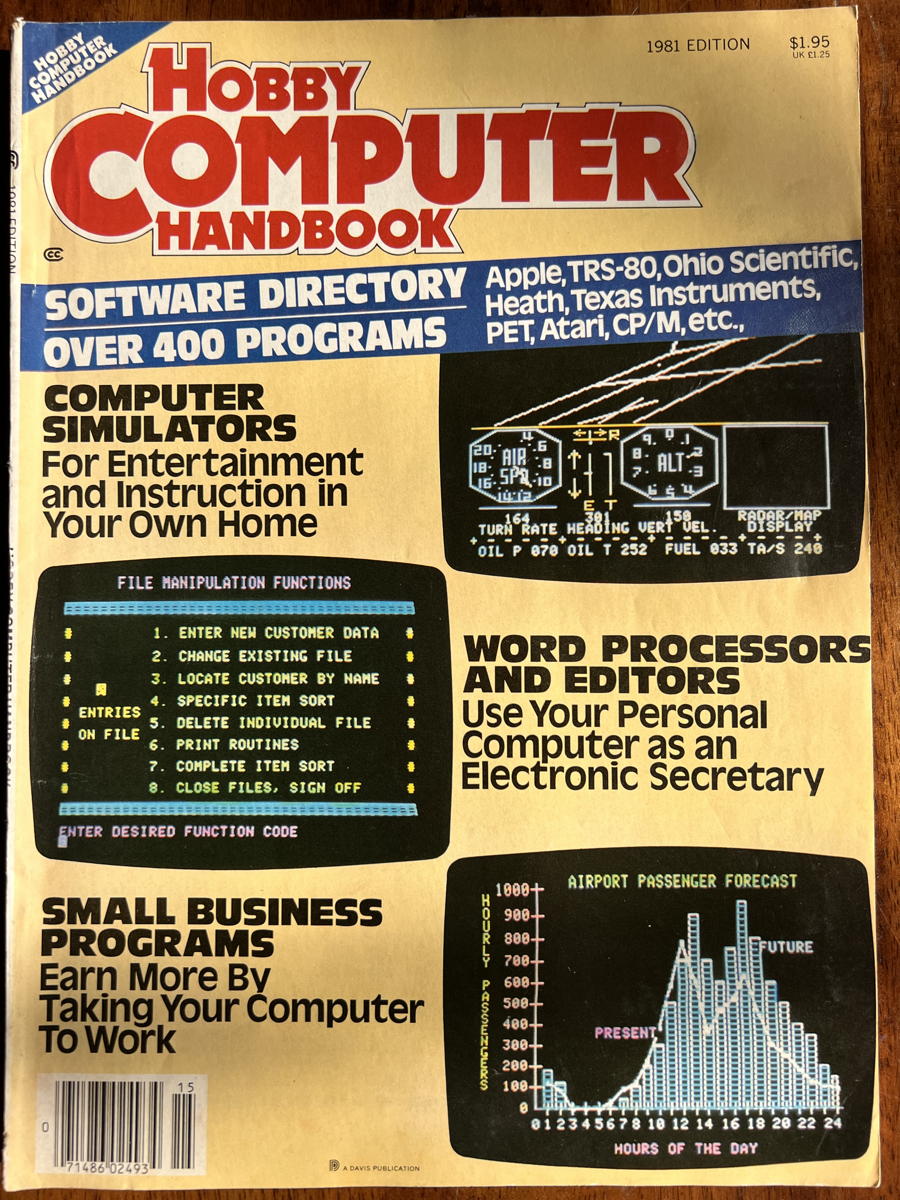Hobby Computer Handbook: From 1979 to 1981
To summarize the previous post, Hobby Computer Handbook was a yearly publication of Elementary Electronics. It lasted from 1979 to 1981, when Elementary Electronics ended publication. I recently found the first and final issues, and it’s a fascinating look at the changes in home computers over a very short time period.
1979
For less than the cost of a decent hi-fi system, or a console color TV with remote control, you can have a computer in your own home as powerful as some of the big IBM jobbies, and the whole computer won’t take up much more space than a couple of shoeboxes. If you don’t have room for two shoeboxes worth of electronic hardware you can rent computer time from regional and national companies… Call Data will charge you as low as $6 per hour (educational rate) for using their computer. If all you need is a couple of hours on their computer per month the bill could be less than your phone company charges you for the privilege of having a telephone.—Herb and Lawrence Friedman, Hobby Computer Handbook 1979 Edition, p. 25
One of the amazing things about how quickly the world of home computers was changing are the articles in the 1979 edition. Hobby Computer Handbook highlighted the SWTP 6800, the Heath H8, the Radio Shack TRS-80, the DATAC 1000T, and the Apple II—along with the Texas Instruments 58 Programmable Calculator.
The SWTP was a kit, for about $1,000 if you wanted a video terminal. Some people apparently didn’t: the Heathkit, also a kit, was $375, plus another $110 for a teletype, preferred over video “because it provides a ‘hard copy.’… Actually, the very minimum, consisting of the computer, 8K of memory, a serial I/O-cassette interface, and a used KSR teletype terminal, will cost around $950.”
Those were kits. You had to literally solder them together yourself. The fully-assembled TRS-80 computer, with 4K of memory, a 12-inch video display monitor, a cassette recorder for storage, and “including a 300 page instruction/programming manual, is $599.95.”
It’s no wonder the TRS-80 was so popular, and no wonder everyone kept telling Radio Shack that it was going to fly off the shelves.
The home computers in this issue were all over the map in terms of functionality. The least useful seems to be the RCA COSMAC VIP, which, like Radio Shack’s competitors, used your “conventional black-and-white TV set”. It was a $249 kit…
…utilizing a special, “easy-to-learn” CHIP-8 hexadecimal language. And if you have a mind to go deeper, you can obtain hands-on experience using machine language… Memory can be increased to 4K bytes by just adding four ICs to the printed circuit card.
You probably would have wanted to spring for a cassette recorder, too, to save those hexadecimal programs. Oh, and you needed to buy an RF modulator to actually use your TV set…
…at $8.50 it seems to be a good value. The kit goes together quite easily if you are able to decipher the rather crude components placement drawings.
If you actually wanted BASIC on your computer, and color on your television set, there was the Apple II, which also came with its own RF modulator and a set of “game paddle controls”. It “sells at $1,045 with 8K of RAM and 8K of ROM. ”
Like the COSMAC, you also needed to spring for a cassette recorder to save your programs and any data they created.1 “The recorder interface operates at 1500 baud, some five times faster than the 300 baud Kansas City standard used by many hobby computers.”
Besides recommending teletype over video, one article played up the usefulness of paper tape.
Paper Tape. The basic recording medium is paper tape, the type with up to eight holes representing each character and parity—called 8-level ASCII… The chief advantage of paper tape is that, unlike magnetic storage systems which are subject to accidental erasure by strong magnetic fields, paper tape is virtually destruction-proof. Short of setting fire to the tape, the recording will last for years and years. Should the tape be damaged it can be easily repaired by a Mylar patch similar to a movie film splice, which is applied by an editing/splicing device also similar to a movie film editor.
You can even use the editor/splicer to remove sections of the recorded programs, or splice in new additions. Makes me want to get a paper tape device for my iMac!
Larry Friedman, author of the horse race program that I loved so much as a kid, had a Mind Bender program in BASIC here, similar to Mastermind. And I do now, too, since I typed it in, but it’s not as useful as other Masterminds I already have for my vintage computers. It’s very barebones and was notable mostly that you could play a game of Mastermind, not that you could play a fun game of Mastermind.
One of the stranger things about this 1979 issue is a note in their article on what kind of BASIC to get.
You can’t even keep a checkbook balanced with an integer basic.
While integer BASICs such as came with the Apple II were limited, checkbooks are one of the few non-integer applications that should work just fine with them. Checks can’t, as far as I know, be written to a fraction of a cent, which means that all you have to do is keep track of the balance in cents instead of dollars in order to use only integers. In a magazine so focused on making do with very limited technology, not recognizing this seems very out of place.

“We call this paper-pushing an Information Explosion.” Computerized word processing took up a lot of space on the desktop in 1981. There’s barely room for paper with the keyboard, monitor, giant disk drives, and printer.
1981
By 1981, the home computer world was expanding to people who didn’t program, and who didn’t like the troublesome process of loading programs. “The first personal computer to offer plug-in ROM cartridges was the Exidy Sorcerer.”2
The grognards at Hobby Computer Handbook worried about this trend toward uneditable software. The Atari 800 was “One of the newest mass-market computers… It has plug-in ROM and RAM cartridges that provide versatility.” The reviewer was very impressed, but…
There are, however, disadvantages to this system. The most serious disadvantage is that programs on a ROM pack cannot be listed and changed.
Everyone who has a computer changes his store-bought programs to better fit his needs. Perhaps it is only changing the wording of the printed output, or maybe it is adding an entirely new subroutine. The point is: The only real difference between a home computer and a video game is the computer’s programmability. These ROM packs do detract from that feature.
The Apple II Plus was also out by 19813, and the infamous Sinclair ZX80, “a real computer for $200.” If a fully-assembled computer revolutionized home computing, a $200 computer made it almost an impulse purchase.

The interesting thing about the Atari was not that it allowed cartridges, but that it required them for what people thought was standard computer use at the time: BASIC wasn’t built in, but required a cartridge.
Prices were dropping among accessories, too. Cassettes were passé in the eighties: disk drives could now be bought on a budget. This made data-critical applications more reasonable for non-technical computer owners. One of these new applications that Hobby Computer Handbook covered was Word Processing.
Computer management of the Information Explosion… The desk of tomorrow will have a printer and computer terminal placed on top. No longer will it be necessary for secretaries to look at reams of paper.
Hobby Computer Handbook also got into the CB craze. An article on online computer groups (mainly the Heath User’s Group” called “Computer CB” highlighted a chat program that simulated a Citizen’s Band confab.
I’m holding a regular QSO on channel 19, but instead of talking into a mike I’m typing my transmission on a keyboard.
The bulk of this issue, however, was the software directory, which took up about half the magazine. Even in 1981 it couldn’t have been anywhere near comprehensive.
As I wrote in 42 Astounding Scripts experienced home computer programmers were often only a few months ahead of the rest of us. These four issues are a fascinating look at a time when computers transitioned from build-your-own to buy-your-own. And even from program-your-own to commercial software that required no programming at all. Cartridges made loading software dead easy while also forbidding the cartridge’s owner from modifying the software.
The experts hadn’t yet figured it out. They were, in essence, a few months behind the rest of us—or a few years. CB Radio in the eighties? That’s even more outdated than expecting the user to edit the software they buy.
In response to Hobby Computer Handbook: Hobby Computer Handbook was a short-lived relic of the early home computer era, an annual (or so) publication of Elementary Electronics.
Assuming the COSMAC was powerful enough to create data; the Apple definitely was.
↑The Exidy Sorceror was also notable for its keyboard: ”Note the numeric keypad, on the right, that makes numerical data easier to program.”
↑In fact, it had been out in 1979, but probably after the publication deadlines of the articles included in the 1979 issues.
↑
- 42 Astoundingly Useful Scripts and Automations for the Macintosh
- MacOS uses Perl, Python, AppleScript, and Automator and you can write scripts in all of these. Build a talking alarm. Roll dice. Preflight your social media comments. Play music and create ASCII art. Get your retro on and bring your Macintosh into the world of tomorrow with 42 Astoundingly Useful Scripts and Automations for the Macintosh!
- Hobby Computer Handbook 1979 Edition at Elementary Electronics Magazine (PDF)
- The first issue of Elementary Electronics’s annual computer magazine.
- Priming the Pump: How TRS-80 Enthusiasts Helped Spark the PC Revolution
- David and Theresa Welsh wrote some of the first great software for the TRS-80, and knew a lot of the other people who were also writing great software. In Priming the Pump, they talk about the history of personal computers and the first non-kit mass-market personal computer, the TRS-80 Model I.
More computer history
- Creative Computing and BASIC Computer Games in public domain
- David Ahl, editor of Creative Computing and of various BASIC Computer Games books, has released these works into the public domain.
- Hobby Computer Handbook
- Hobby Computer Handbook was a short-lived relic of the early home computer era, an annual (or so) publication of Elementary Electronics.
- 8 (bit) Days of Christmas: Day 11 (O Christmas Tree)
- Day 11 of the 8 (bit) days of Christmas is the graphic accompaniment to “O Tannenbaum” from Robert T. Rogers “Holly Jolly Holidays”, from December 1984.
- 8 (bit) Days of Christmas: Day 100 (Hearth)
- Lower resolution graphics were more appropriate for animation, because you could page through up to eight screens like a flip book. This is Eugene Vasconi’s Holiday Hearth from December 1986.
- 8 (bit) Days of Christmas: Day 101 (Rudolph)
- An early form of musical ebook, without scenes illustrating the progress of the song—in this case, Rudolph the Red-Nosed Reindeer. Along with the secret world of POKE.
- Six more pages with the topic computer history, and other related pages
More eighties
- Hesperia Class of ’82
- The 40th reunion for the Hesperia High School Class of 1982 is July 15 through July 17, 2022. We look forward to seeing you!
- Nothing will be restrained from them, which they imagine to do
- Figuring out stuff from “the times before” is hard to do.
More Hobby Computer Handbook
- Hobby Computer Handbook
- Hobby Computer Handbook was a short-lived relic of the early home computer era, an annual (or so) publication of Elementary Electronics.
More magazines
- Hobby Computer Handbook
- Hobby Computer Handbook was a short-lived relic of the early home computer era, an annual (or so) publication of Elementary Electronics.
More seventies
- Plain & Fancy in the seventies with Hiram Walker
- Enjoy a whole new world of fun, excitement and discovery in Hiram Walker Cordials, adding a personal touch to all your memorable moments and special occasions—plain or fancy!
- A Bicentennial Meal for the Sestercentennial
- Four community cookbooks celebrating the bicentennial. As we approach our sestercentennial in 2026, what makes a meal from 1976?
- Hesperia Class of ’82
- The 40th reunion for the Hesperia High School Class of 1982 is July 15 through July 17, 2022. We look forward to seeing you!
- Better for being ridden: the eternal lie of the anointed
- Whenever there’s a crisis, politicians and the media always tell us that if we do what they say, we’ll be all right. This is always a lie. And however often they fail and however many die from their ministrations, their wabbling fingers always return to the mire.
- All the President’s Men
- Probably one of the most influential events in journalism history made into one of the best films of the seventies.
- Five more pages with the topic seventies, and other related pages




